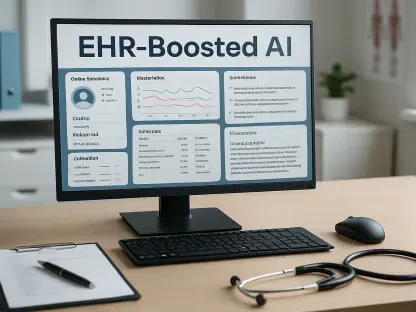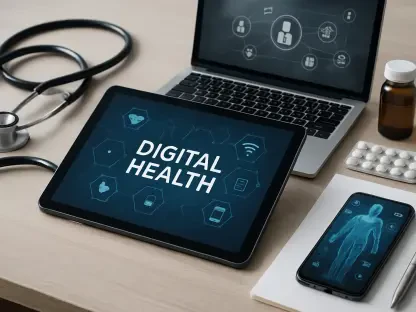The healthcare sector faces a dual challenge: safeguarding sensitive patient data while ensuring clinical operations remain smooth and effective. The evolving landscape of cyber threats, particularly ransomware, adds complexity to this task. This article delves into the intricate balance needed between robust cybersecurity measures and maintaining clinical usability.
The Evolving Cyber Threat Landscape
Ransomware’s Growing Sophistication
Cybercriminals are honing their tactics, with ransomware increasingly targeting healthcare delivery organizations and centralized service providers in the supply chain. This evolution magnifies the potential impact, affecting multiple entities across various industries. The sophistication of these attacks means that successful breaches can result in significant operational disruptions and data breaches that extend far beyond the initially targeted organization. By infiltrating service providers, cybercriminals can compromise the operations of numerous healthcare entities in addition to other industries that rely on these services.
Ransomware attacks on the healthcare sector have evolved in both strategy and tactics, making them increasingly challenging to defend against. These attacks have transitioned from simple encryption of critical data to more complex operations involving the exfiltration of sensitive data before encryption. This two-pronged approach adds additional pressure on healthcare organizations, as they must now contend with the threat of data leaks in addition to operational downtime. Cybercriminals exploit the urgency and high stakes associated with patient care, knowing that healthcare organizations are more likely to pay ransoms to resume normal operations swiftly and protect patient data.
High Stakes of Patient Data Protection
The vulnerabilities intrinsic to healthcare systems, coupled with the high value of patient data, make the sector an attractive target for cybercriminals. Regulatory fines and reputational damage from data breaches add pressure on healthcare organizations. Patient data includes sensitive information such as medical histories, treatment records, and personal identifiers, all of which are highly valuable on the black market. Cybercriminals target this data for financial gain, and the implications of a breach can be severe for both the organization and the patients affected.
Additionally, healthcare organizations must navigate a complex regulatory landscape designed to protect patient privacy and data security. Non-compliance with these regulations can result in substantial fines and legal penalties, further exacerbating the financial impact of a data breach. Beyond monetary consequences, the reputational harm from a data breach can lead to loss of patient trust, reduced patient volumes, and even downgraded bond ratings. Healthcare organizations are thus faced with the daunting task of safeguarding patient data while maintaining their operational effectiveness and upholding their reputations.
Challenges of Safeguarding Patient Data
Legacy Systems and Cyber Defenses
Healthcare relies on many outdated systems crucial for patient care but lacking in modern cybersecurity features. Vendors are often slow to provide patches and updates, exacerbating vulnerabilities within these systems. These legacy systems may have been designed during a time when cybersecurity threats were less prevalent, and as a result, they lack the necessary defenses to withstand modern attacks. The integration of these systems with newer technologies adds an additional layer of complexity, as securing them without disrupting clinical workflows can be challenging.
Legacy systems often play a vital role in patient care, making it difficult to replace them without impacting clinical services. This reliance on outdated technologies exposes healthcare organizations to significant risks, including the potential for unauthorized access, data leaks, and system outages. The slow response of vendors in providing timely patches and updates leaves healthcare providers vulnerable to known exploits, further complicating their security posture. Addressing these vulnerabilities requires a comprehensive approach that includes regular risk assessments, the implementation of compensating controls, and collaboration with vendors to enhance system security.
Flat Network Architectures
The design of healthcare networks aims to facilitate seamless intercommunication between devices but also simplifies the path for cyber attackers to exploit these networks. Flat network architectures, which are common in healthcare settings, create an environment where devices and systems are interconnected without sufficient segmentation. While this design supports efficient data sharing and improves patient care efficiency, it also means that once an attacker gains access to the network, they can move laterally with relative ease to compromise other systems and data.
Flat networks are particularly concerning in environments that rely on a wide array of interconnected medical devices, each with varying levels of security. The interconnectivity extends to third-party systems and services, further increasing the risk exposure. To mitigate these risks, healthcare organizations need to adopt more advanced network segmentation strategies that create isolated security zones within the network. By segmenting the network, organizations can limit the movement of attackers, contain potential breaches, and protect sensitive data more effectively.
Achieving a Balanced Approach
Proactive Data Segmentation
Healthcare organizations need to clearly define and control where patient data is stored and accessed, whether in Electronic Medical Records (EMRs), cloud services, or Picture Archiving and Communication Systems (PACS). This targeted approach to data protection helps maintain both security and usability. Implementing proactive data segmentation involves identifying the various repositories where patient data resides and establishing strict access controls and monitoring mechanisms.
Effective data segmentation requires a thorough understanding of the data flows within the organization and the potential points of vulnerability. Organizations must implement encryption, access controls, and monitoring solutions to ensure that data remains protected both in transit and at rest. This involves not only technological measures but also the development and enforcement of policies governing data access and usage. By adopting a proactive approach to data segmentation, healthcare providers can protect sensitive patient information while ensuring it remains readily accessible to authorized personnel for clinical use.
Minimizing Clinical Friction
Implementing security measures should not overly disrupt clinical workflows, which could lead to clinician burnout. Effective cybersecurity involves a deep understanding of clinical operations and rigorous testing to ensure minimal disruption. Security teams must work closely with clinical staff to identify pain points and develop solutions that integrate seamlessly into existing workflows. This collaboration helps ensure that security measures do not impede the delivery of patient care.
Clinical friction occurs when security protocols create barriers to accessing information or completing tasks, leading to frustration and reduced productivity. To minimize clinical friction, organizations must strike a balance between robust security controls and user-friendly solutions. This can be achieved through thorough user testing, iterative refinement of security measures, and ongoing training and support for clinical staff. By prioritizing usability alongside security, healthcare organizations can foster a more secure environment without compromising the efficiency and effectiveness of clinical operations.
Practical Strategies for Collaboration
Educating Clinical Staff on Cybersecurity
Healthcare organizations must foster an environment where security measures are understood and accepted by clinical staff. This requires educating clinicians about the importance of cybersecurity and how it aligns with patient safety. Ongoing education and awareness campaigns can help bridge the knowledge gap and promote a culture of security within the organization. Clinicians need to be aware of the latest cybersecurity threats, best practices for protecting patient data, and their role in mitigating risks.
Effective education programs should be tailored to the specific needs and workflows of clinical staff, providing them with practical, actionable insights. This includes training on recognizing phishing attempts, securing mobile devices, and following protocols for data access and sharing. Building a strong security culture involves regular communication, feedback, and reinforcement of key security principles. By equipping clinicians with the knowledge and tools they need to protect sensitive data, healthcare organizations can enhance their overall security posture.
Leveraging Existing Clinical Processes
The healthcare sector faces the challenge of protecting sensitive patient data while ensuring smooth and effective clinical operations. The rising frequency and sophistication of cyber threats, especially ransomware, complicates this task further. Cybersecurity in healthcare isn’t just about employing the most advanced technology; it’s about striking the perfect balance between robust security protocols and maintaining clinical usability and efficiency. This article delves deeper into the delicate equilibrium required to safeguard patient information without disrupting the essential medical services that healthcare providers offer. The need for heightened cybersecurity has never been greater, but it is equally important that these measures do not hinder the day-to-day activities of healthcare professionals. Balancing comprehensive security with clinical functionality is now a critical priority as the sector evolves to meet both technological advancements and emerging threats.









